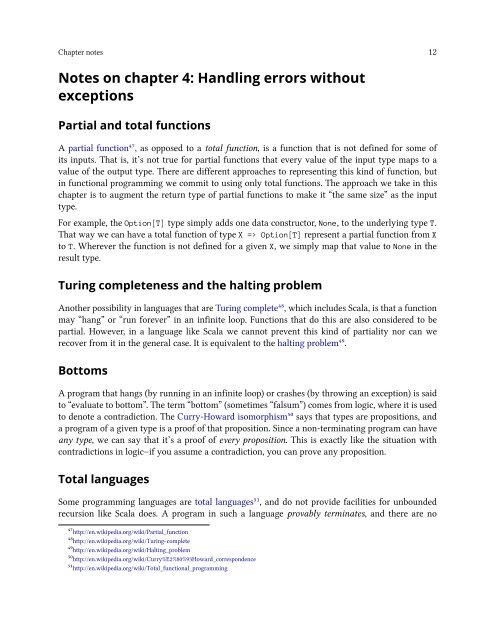Programming in Scala”
fpiscompanion
fpiscompanion
Create successful ePaper yourself
Turn your PDF publications into a flip-book with our unique Google optimized e-Paper software.
Chapter notes 12<br />
Notes on chapter 4: Handl<strong>in</strong>g errors without<br />
exceptions<br />
Partial and total functions<br />
A partial function⁴⁷, as opposed to a total function, is a function that is not def<strong>in</strong>ed for some of<br />
its <strong>in</strong>puts. That is, it’s not true for partial functions that every value of the <strong>in</strong>put type maps to a<br />
value of the output type. There are different approaches to represent<strong>in</strong>g this k<strong>in</strong>d of function, but<br />
<strong>in</strong> functional programm<strong>in</strong>g we commit to us<strong>in</strong>g only total functions. The approach we take <strong>in</strong> this<br />
chapter is to augment the return type of partial functions to make it “the same size” as the <strong>in</strong>put<br />
type.<br />
For example, the Option[T] type simply adds one data constructor, None, to the underly<strong>in</strong>g type T.<br />
That way we can have a total function of type X => Option[T] represent a partial function from X<br />
to T. Wherever the function is not def<strong>in</strong>ed for a given X, we simply map that value to None <strong>in</strong> the<br />
result type.<br />
Tur<strong>in</strong>g completeness and the halt<strong>in</strong>g problem<br />
Another possibility <strong>in</strong> languages that are Tur<strong>in</strong>g complete⁴⁸, which <strong>in</strong>cludes Scala, is that a function<br />
may “hang” or “run forever” <strong>in</strong> an <strong>in</strong>f<strong>in</strong>ite loop. Functions that do this are also considered to be<br />
partial. However, <strong>in</strong> a language like Scala we cannot prevent this k<strong>in</strong>d of partiality nor can we<br />
recover from it <strong>in</strong> the general case. It is equivalent to the halt<strong>in</strong>g problem⁴⁹.<br />
Bottoms<br />
A program that hangs (by runn<strong>in</strong>g <strong>in</strong> an <strong>in</strong>f<strong>in</strong>ite loop) or crashes (by throw<strong>in</strong>g an exception) is said<br />
to “evaluate to bottom”. The term “bottom” (sometimes “falsum”) comes from logic, where it is used<br />
to denote a contradiction. The Curry-Howard isomorphism⁵⁰ says that types are propositions, and<br />
a program of a given type is a proof of that proposition. S<strong>in</strong>ce a non-term<strong>in</strong>at<strong>in</strong>g program can have<br />
any type, we can say that it’s a proof of every proposition. This is exactly like the situation with<br />
contradictions <strong>in</strong> logic–if you assume a contradiction, you can prove any proposition.<br />
Total languages<br />
Some programm<strong>in</strong>g languages are total languages⁵¹, and do not provide facilities for unbounded<br />
recursion like Scala does. A program <strong>in</strong> such a language provably term<strong>in</strong>ates, and there are no<br />
⁴⁷http://en.wikipedia.org/wiki/Partial_function<br />
⁴⁸http://en.wikipedia.org/wiki/Tur<strong>in</strong>g-complete<br />
⁴⁹http://en.wikipedia.org/wiki/Halt<strong>in</strong>g_problem<br />
⁵⁰http://en.wikipedia.org/wiki/Curry%E2%80%93Howard_correspondence<br />
⁵¹http://en.wikipedia.org/wiki/Total_functional_programm<strong>in</strong>g


